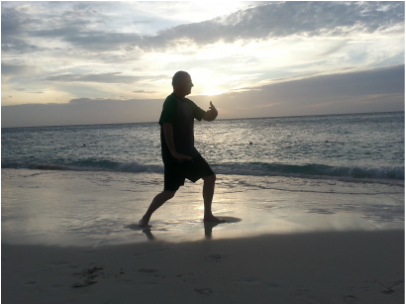Tai Chi or TaijiquanScientifically verified benefits:
Taijiquan is an excellent mind body exercise, integrating internal kung fu, meditative awareness, Taoist philosophy, and the physics of efficient movement. Taijiquan (Tai Chi Chuan) Videos Master Yang Jun, Yang Family lineage holder teaches Yang Long Form https://www.youtube.com/user/yangfamilytaichi Master Arthur Du, excellent videos https://www.youtube.com/channel/UCe896AvH3-H Master Arthur Du, Yang 24 Taijiquan www.youtube.com/watch?v=BsZU8r_nujE&t=8s Master Liang, Simplified Yang 24 Short Form https://www.youtube.com/watch?v=5LsyuDmI8YI Yang 24 Taijiquan (rear/side view)http://www.youtube.com/watch?v=8X16NbG0pM0 24 Tai chi with the english name of each movement performed by a Chinese Taijiquan champion ("the Lady in Pink"). Please be aware that her stance is too low for most people. She is young and has developed her ability from intensive training at an early age! https://www.youtube.com/watch?v=Ua-M7js0F0g Ian Sinclair's instructional video's: http://www.youtube.com/watch?v=Tetf79WQta4&list=PLCB98FB48CFE9D3C9 Bruce Frantzis has some excellent Tai Chi tips here: https://www.youtube.com/channel/UC4ABDVU2Aj-jIIk1ca-A6WA Master Chen Zheng Lei Demonstrates Chen Style Tai Chi www.youtube.com/watch?v=CSklD1go8Jk Master Dong Huling demonstrates Yang style long form https://www.youtube.com/watch?v=ehPZDEB4opI&t=519s Gary McCabe's Taijiquan Classes Learn 24 step Yang style Taijiquan (Tai chi chuan), the same form practiced in parks throughout China. Widely known as "the Short Form", it is the most popular in the world, enjoyed by millions. What is it? While witnessing the peaceful flowing movements of Yang style, it may be hard to believe that Taijiquan (Tai chi chuan) means "grand ultimate fist". Most people practice Taiji solely for its health benefits and may have no interest in its martial dimension. It is difficult to know the true origins of Taijiquan. Some claim it began at Wudang mountain, others say the Shaolin temple had a form of Taiji, but most acknowledge that Chen family style is the oldest verifiable form of Taijiquan. Today, there is a place known as Chen village where family members are dedicated to the preservation and promotion of their art. Chen style is characterized by slow, even movements alternating with powerfully explosive ones. It is often done in a lower stance and is more martial looking, with explosive kicks, punches, elbow strikes and joint locking techniques evident. Yang Lu Chan was the first person outside the Chen family to learn their style and later created a very different version of Taijiquan. He may have had other influences besides Chen style, but some believe that he basically made the large spirals, circular movements and martial aspects less obvious and more internal. His grandson, Yang Cheng Fu, modified this form further and eliminated its most vigorous martial movements. His style is recognizable by its flowing, continuous tempo. Yang Cheng Fu traveled widely, successfuly promoting his art and soon his Yang Taijiquan Long form (85 step) and Tuishou (push hands) became famous. Yang style also has a martial version which is less well known. Its training is far more extensive and intense than the popular style. In 1956 a group of Yang style Taiji Masters were commissioned by the Chinese government to create a simple, shorter form for the public. The 24 step Tai chi form was the result of their research. It has a focus on health, is easier to learn and can be done in under 7 minutes. Its combination of flowing movement, stable footing and awareness to detail make it a perfect remedy to modern stress and tension. Even watching a good Tai Chi Chuan performance is relaxing, but only actual practice will reveal its mysterious power to recharge you, boost immunity and calm your mind. Modern practitioners continue to find that Taijiquan can become a source of endless fascination and deepening well being. Key Concepts
US trail study of Tai Chi for fibromyalgia Book Recommendations The Tai Chi Space by Paul Cavel 40 principles to bring your Taijiquan and Qigong practices to deeper levels. Tai Chi in 10 Weeks-Beginner's Guide by Dr. Aihan Kuhn Best beginner's book for Simplified Yang Style. The Yang Taiji 24 Step Short Form by James Drewe Intermediate level, very detailed book on the 24 Yang form. Mastering Yang Style Taijiquan by Fu Zhongwen About the Yang 85 long form. (Taijiquan philosophy)- brennantranslation.wordpress.com/2012/08/27/the-taiji-manual-of-xu-yusheng/ Additional Taiji Videos
Yang style Martial applications- an external view (you can't easily see the internal) www.youtube.com/watch?v=nuvLWEsw_hw Yang 24 Taijiquan Sequence 1 Commencing (Qishì) 2 Part the Wild Horse's Mane (Yéma Fenzong) 3 White Crane Spreads Its Wings (Báihè Lìangchì) 4 Brush Knee and twist step (Louxi aobù) 5 Playing the Lute (Shouhui Pípa) 6 Repulse Monkey (Daojuan Gong) 7 Grasp the Bird's Tail (ZuoLan Quewei) a) Ward Off (Peng) b) Rollback (Lu) c) Press (Ji) d) Push (An) 8 Right Grasp Bird's Tail (You Lan Quewei) 9 Single Whip (Danbian) 10 Wave Hands Like Clouds (Yunshou) 11 Single Whip (Danbian) 12 High Pat on Horse (Gao Tan Ma) 13 Right Heel Kick (You Dengjiao) 14 Strike to Ears with Both Fists (Shuangfeng Guaner) 15 Turn Body and Left Heel Kick (Zhuanshen Zuo Dengjiao) 16 Left Lower Body and Stand on One Leg (Zuo Xiashi Duli) a) Snake Creeps Down, b) Golden Rooster Stands on One Leg 17 Right Snake creeps down, Golden Rooster Stands on one leg 18 Play the Shuttle (Yunu Chuansuo) 19 Needle at Sea Bottom (Haidi Zhen) 20 Fan Through Back (Shan Tong Bei) 21 Turn Body, Deflect, Parry, and Punch (Zhuanshen Banlanchui) 22 Appears Closed (Rufeng Sibi), Withdraw and Push, as if Closing a Door 23 Cross Hands (Shizishou) 24 Closing (Shoushi) Sunday Co-operative Push hands Practice (Tui Shou)
at the Veteran Park, Parsippany, NJ This is not a teaching environment, but anyone who has at least 5 years Taijiquan practice and would like to explore push hands in a friendly way is welcome. A group of Taiji Quan practitioners practice "Push Hands" at the Veterans Park, Parsippany, NJ 07054 (The entrance to Veterans Memorial Park is located on Route 46 East at Vail Road, directly after Cerbo's Lumber) every Sunday morning from 9:30 AM to 12:00 PM. Email me before attending. |
